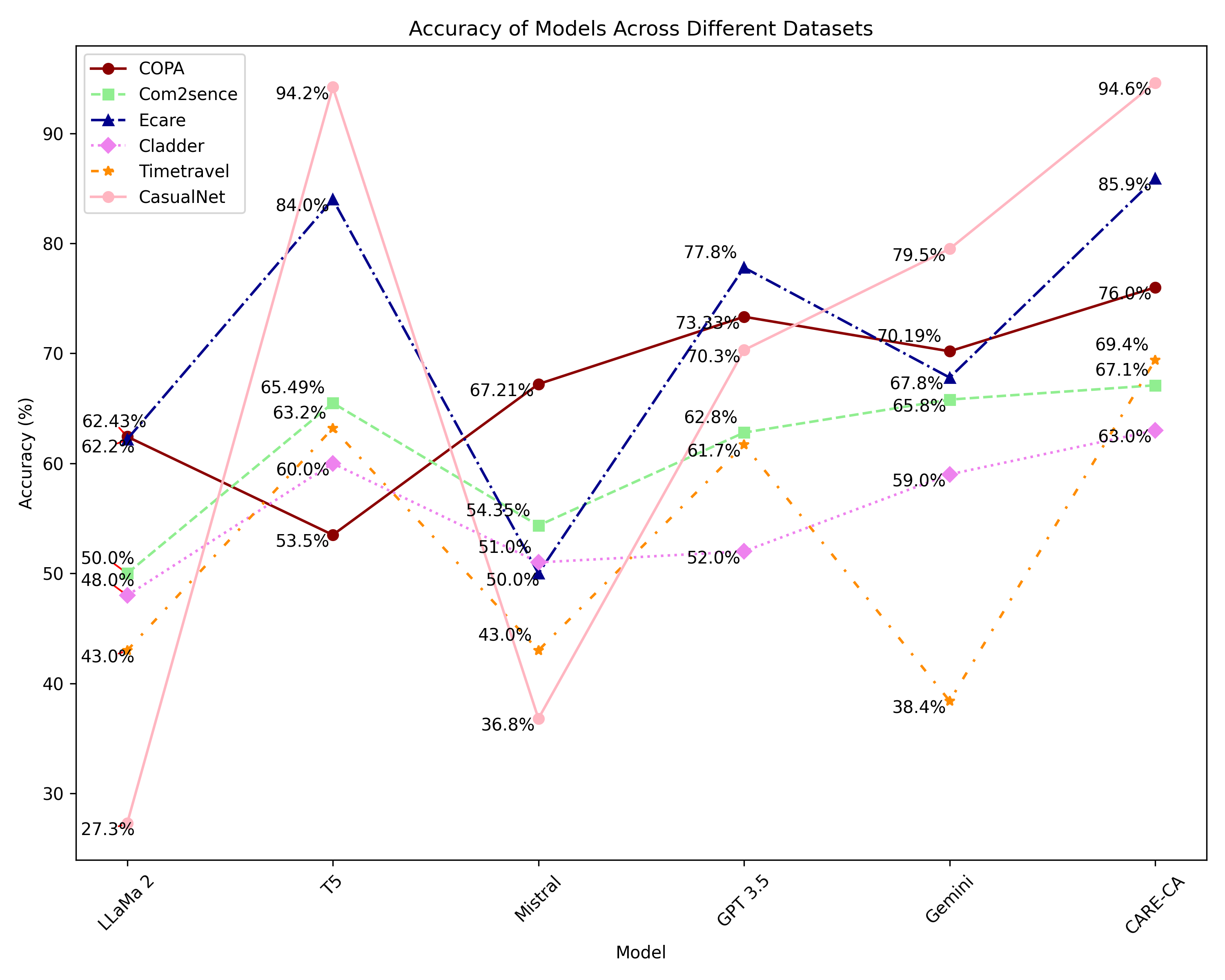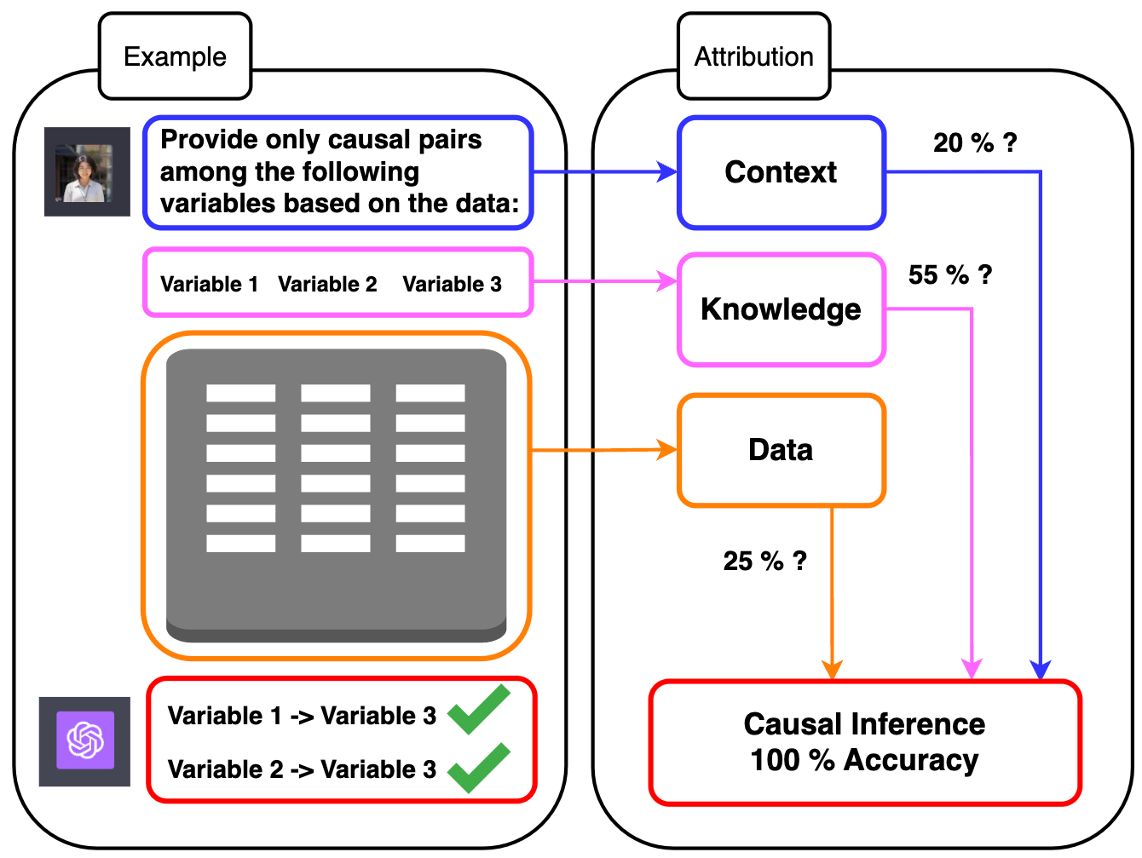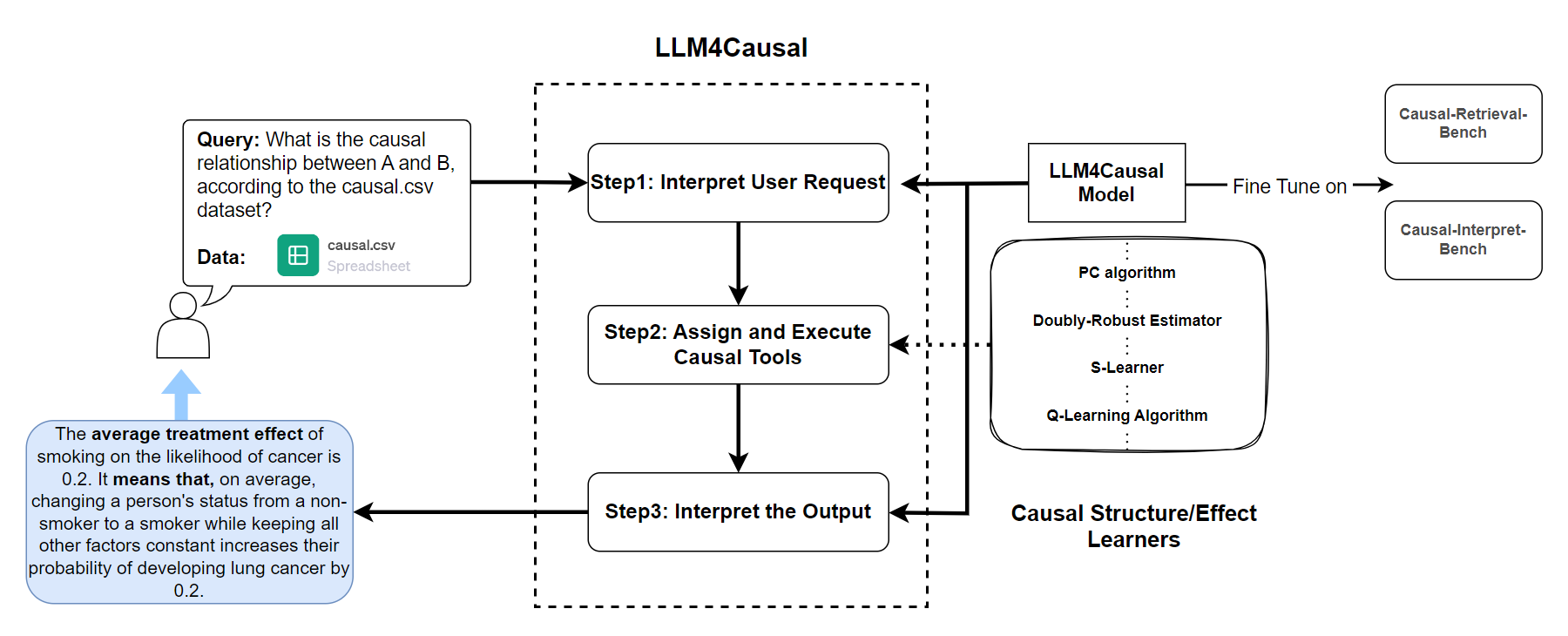Cause and Effect: Can Large Language Models Truly Understand Causality?
2402.18139

0
0

Abstract
With the rise of Large Language Models(LLMs), it has become crucial to understand their capabilities and limitations in deciphering and explaining the complex web of causal relationships that language entails. Current methods use either explicit or implicit causal reasoning, yet there is a strong need for a unified approach combining both to tackle a wide array of causal relationships more effectively. This research proposes a novel architecture called Context Aware Reasoning Enhancement with Counterfactual Analysis(CARE CA) framework to enhance causal reasoning and explainability. The proposed framework incorporates an explicit causal detection module with ConceptNet and counterfactual statements, as well as implicit causal detection through LLMs. Our framework goes one step further with a layer of counterfactual explanations to accentuate LLMs understanding of causality. The knowledge from ConceptNet enhances the performance of multiple causal reasoning tasks such as causal discovery, causal identification and counterfactual reasoning. The counterfactual sentences add explicit knowledge of the not caused by scenarios. By combining these powerful modules, our model aims to provide a deeper understanding of causal relationships, enabling enhanced interpretability. Evaluation of benchmark datasets shows improved performance across all metrics, such as accuracy, precision, recall, and F1 scores. We also introduce CausalNet, a new dataset accompanied by our code, to facilitate further research in this domain.
Create account to get full access
Overview
- This paper explores whether large language models (LLMs) can truly understand causality, a crucial ability for making reliable decisions.
- The researchers investigate the causal reasoning capabilities of LLMs using CausalBench, a comprehensive benchmark designed to evaluate causal learning and reasoning.
- The paper also examines the potential for LLMs to exhibit counterintuitive behaviors regarding causal understanding, as demonstrated in Counter-Intuitive: Large Language Models Can Better.
- Additionally, the paper discusses the importance of quantifying and mitigating unimodal biases in multimodal LLMs, as explored in Quantifying and Mitigating Unimodal Biases in Multimodal Large Language.
Plain English Explanation
This paper investigates whether large language models (LLMs), which are powerful AI systems that can generate human-like text, truly understand the concept of causality. Causality is the relationship between cause and effect, and it's a crucial ability for making reliable decisions.
The researchers use a benchmark called CausalBench to evaluate the causal reasoning capabilities of LLMs. CausalBench is designed to test how well these models can learn and reason about causal relationships. The paper also explores the possibility that LLMs might exhibit counterintuitive behaviors when it comes to their understanding of causality, as shown in previous research.
Furthermore, the paper discusses the importance of addressing biases in multimodal LLMs, which are models that can process and generate text, images, and other types of data. These biases can lead to inaccurate or unfair decision-making, so it's crucial to find ways to quantify and mitigate them.
Overall, this paper dives into the complex topic of causal reasoning in large language models, which has important implications for the development of reliable and trustworthy AI systems.
Technical Explanation
The paper investigates the causal reasoning capabilities of large language models (LLMs) using CausalBench, a comprehensive benchmark designed to evaluate causal learning and reasoning. CausalBench includes a diverse set of causal tasks, such as causal discovery, causal intervention, and causal counterfactual reasoning.
The researchers also examine the potential for LLMs to exhibit counterintuitive behaviors regarding causal understanding, as demonstrated in Counter-Intuitive: Large Language Models Can Better. This prior work showed that LLMs can sometimes outperform human experts in causal reasoning tasks, despite their lack of explicit causal knowledge.
Additionally, the paper discusses the importance of quantifying and mitigating unimodal biases in multimodal LLMs, as explored in Quantifying and Mitigating Unimodal Biases in Multimodal Large Language. Unimodal biases refer to biases that arise from the individual modalities (e.g., text, images) used to train the model, which can lead to inaccurate or unfair decision-making when the model is applied to multimodal tasks.
Critical Analysis
The paper raises important questions about the causal reasoning capabilities of large language models and highlights the need for more comprehensive benchmarking and evaluation of these systems.
While the research suggests that LLMs can exhibit counterintuitive behaviors when it comes to causal reasoning, the paper acknowledges the limitations of the current study and the need for further investigation. The researchers note that the observed behaviors may be influenced by the specific tasks and datasets used in the experiments, and that more research is needed to fully understand the underlying mechanisms and generalizability of these findings.
Additionally, the paper's discussion of unimodal biases in multimodal LLMs is an important consideration, as these biases can have significant implications for the real-world application of these models. However, the paper does not provide a detailed analysis of the specific types of biases that were identified or the effectiveness of the proposed mitigation strategies.
Overall, the paper provides a valuable contribution to the ongoing research on causal reasoning in large language models, but there are still many open questions and areas for further exploration.
Conclusion
This paper explores the complex issue of whether large language models can truly understand causality, a crucial ability for making reliable decisions. The researchers use CausalBench, a comprehensive benchmark, to evaluate the causal reasoning capabilities of LLMs, and they also examine the potential for counterintuitive behaviors in these models.
Additionally, the paper discusses the importance of addressing unimodal biases in multimodal LLMs, which can lead to inaccurate or unfair decision-making. While the research provides valuable insights, it also highlights the need for continued investigation and the development of more robust evaluation methods to fully understand the causal reasoning capabilities of these powerful AI systems.
This summary was produced with help from an AI and may contain inaccuracies - check out the links to read the original source documents!
Related Papers

Is Knowledge All Large Language Models Needed for Causal Reasoning?
Hengrui Cai, Shengjie Liu, Rui Song

0
0
This paper explores the causal reasoning of large language models (LLMs) to enhance their interpretability and reliability in advancing artificial intelligence. Despite the proficiency of LLMs in a range of tasks, their potential for understanding causality requires further exploration. We propose a novel causal attribution model that utilizes ``do-operators for constructing counterfactual scenarios, allowing us to systematically quantify the influence of input numerical data and LLMs' pre-existing knowledge on their causal reasoning processes. Our newly developed experimental setup assesses LLMs' reliance on contextual information and inherent knowledge across various domains. Our evaluation reveals that LLMs' causal reasoning ability mainly depends on the context and domain-specific knowledge provided. In the absence of such knowledge, LLMs can still maintain a degree of causal reasoning using the available numerical data, albeit with limitations in the calculations. This motivates the proposed fine-tuned LLM for pairwise causal discovery, effectively leveraging both knowledge and numerical information.
6/6/2024

Large Language Model for Causal Decision Making
Haitao Jiang, Lin Ge, Yuhe Gao, Jianian Wang, Rui Song

0
0
Large Language Models (LLMs) have shown their success in language understanding and reasoning on general topics. However, their capability to perform inference based on user-specified structured data and knowledge in corpus-rare concepts, such as causal decision-making is still limited. In this work, we explore the possibility of fine-tuning an open-sourced LLM into LLM4Causal, which can identify the causal task, execute a corresponding function, and interpret its numerical results based on users' queries and the provided dataset. Meanwhile, we propose a data generation process for more controllable GPT prompting and present two instruction-tuning datasets: (1) Causal-Retrieval-Bench for causal problem identification and input parameter extraction for causal function calling and (2) Causal-Interpret-Bench for in-context causal interpretation. By conducting end-to-end evaluations and two ablation studies, we showed that LLM4Causal can deliver end-to-end solutions for causal problems and provide easy-to-understand answers, which significantly outperforms the baselines.
4/15/2024

Large Language Models for Constrained-Based Causal Discovery
Kai-Hendrik Cohrs, Gherardo Varando, Emiliano Diaz, Vasileios Sitokonstantinou, Gustau Camps-Valls

0
0
Causality is essential for understanding complex systems, such as the economy, the brain, and the climate. Constructing causal graphs often relies on either data-driven or expert-driven approaches, both fraught with challenges. The former methods, like the celebrated PC algorithm, face issues with data requirements and assumptions of causal sufficiency, while the latter demand substantial time and domain knowledge. This work explores the capabilities of Large Language Models (LLMs) as an alternative to domain experts for causal graph generation. We frame conditional independence queries as prompts to LLMs and employ the PC algorithm with the answers. The performance of the LLM-based conditional independence oracle on systems with known causal graphs shows a high degree of variability. We improve the performance through a proposed statistical-inspired voting schema that allows some control over false-positive and false-negative rates. Inspecting the chain-of-thought argumentation, we find causal reasoning to justify its answer to a probabilistic query. We show evidence that knowledge-based CIT could eventually become a complementary tool for data-driven causal discovery.
6/12/2024

CausalBench: A Comprehensive Benchmark for Causal Learning Capability of Large Language Models
Yu Zhou, Xingyu Wu, Beicheng Huang, Jibin Wu, Liang Feng, Kay Chen Tan

0
0
Causality reveals fundamental principles behind data distributions in real-world scenarios, and the capability of large language models (LLMs) to understand causality directly impacts their efficacy across explaining outputs, adapting to new evidence, and generating counterfactuals. With the proliferation of LLMs, the evaluation of this capacity is increasingly garnering attention. However, the absence of a comprehensive benchmark has rendered existing evaluation studies being straightforward, undiversified, and homogeneous. To address these challenges, this paper proposes a comprehensive benchmark, namely CausalBench, to evaluate the causality understanding capabilities of LLMs. Originating from the causal research community, CausalBench encompasses three causal learning-related tasks, which facilitate a convenient comparison of LLMs' performance with classic causal learning algorithms. Meanwhile, causal networks of varying scales and densities are integrated in CausalBench, to explore the upper limits of LLMs' capabilities across task scenarios of varying difficulty. Notably, background knowledge and structured data are also incorporated into CausalBench to thoroughly unlock the underlying potential of LLMs for long-text comprehension and prior information utilization. Based on CausalBench, this paper evaluates nineteen leading LLMs and unveils insightful conclusions in diverse aspects. Firstly, we present the strengths and weaknesses of LLMs and quantitatively explore the upper limits of their capabilities across various scenarios. Meanwhile, we further discern the adaptability and abilities of LLMs to specific structural networks and complex chain of thought structures. Moreover, this paper quantitatively presents the differences across diverse information sources and uncovers the gap between LLMs' capabilities in causal understanding within textual contexts and numerical domains.
4/10/2024